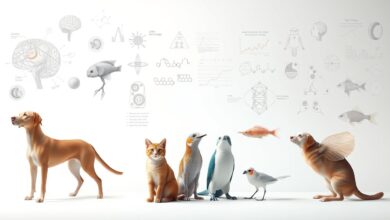Can Pets Understand Humans? Science Says Yes!

Ever wondered if your dog knows when you’re happy or if your cat notices when you’re stressed? New studies show pets do more than just react to treats. They actually understand human emotions and communication in surprising ways. It’s time to debunk myths and embrace the truth!
Learn how pet behavior and animal communication are changing our understanding of the human-animal bond. From understanding barks to silent tail wags, this article reveals how your pet’s brain is more connected to you than you might think. Are you ready to see your furry friend in a new light?
The Science Behind Pet-Human Communication
Scientists are learning how pets see and talk to humans through new research. They’re using advanced tools to understand pets cognition and pet psychology.
How Researchers Study Animal Cognition
Researchers find creative ways to read your pet’s mind. Here’s how they do it:
- Controlled experiments track reactions to words or gestures
- Observational studies record natural behaviors in home settings
- Comparative tests compare responses across species
Recent Breakthroughs in Understanding Pet Intelligence
Studies show pets have surprising skills. Dogs, for example, process words and emotions in different parts of their brain, just like us. Research from Hungary’s Eötvös Loránd University found this dual processing. It shows pets understand more than we thought.

The Neurological Basis of Cross-Species Communication
Brains are key to understanding. Advanced imaging shows special brain paths light up when pets hear voices or see faces. These paths suggest pets cognition has evolved to grasp our emotions and commands. It’s like a built-in translator between species!
How Dogs Process Human Language and Gestures
Dogs are experts at understanding humans. They use their instincts and learn from us to get what we mean. Studies show they know many words and can tell if we’re happy or upset.

Watch how your dog reacts to pointing. Unlike wolves, dogs follow your finger to find treats. This shows their special way of communicating with us. They also look at our faces to see how we’re feeling.
- Words: Processed in brain regions similar to how humans handle language.
- Tone: Vibrato-like vocal pitches trigger excitement (think high-pitched praise).
- Body language: Follows gestures like no other non-human species.
Some dog breeds are even better at understanding us. Herding dogs like Border Collies quickly get hand signals. Hounds, on the other hand, use their sense of smell more.
Every movement your dog makes tells you something. A wagging tail means they’re happy. A stern tone makes them stop playing right away. Science shows that dogs really listen to us.
Can Pets Understand Humans? Science Says Yes!
Recent studies show pets understand more than just treats. Dogs like Rico and Chaser know hundreds of words. This proves pet behavior is not just instinct—it’s learned communication.
Evidence from Behavioral Studies
Border collies like Rico and Chaser learned over 1,000 words and basic grammar. They can understand new commands, like fetching a “new” toy. This shows their minds are more complex than simple training:
- Rico identified objects by name without prior exposure
- Chaser obeyed complex commands like “fetch the shoe to the ball”
- Cats recognize their names despite seeming aloof
Brain Imaging Reveals Surprising Results
Scans show dogs’ brains react uniquely to their owners’ voices. This activates areas linked to emotional processing, similar to humans. Key findings include:
- Owners’ voices trigger stronger brain activity than strangers’
- Specific brain areas light up for familiar commands like “sit”
What Scientists Have Discovered About Pet Perception
Your pet notices more than you think. Dogs read facial expressions and sense moods. Cats track emotional tones in your voice. These discoveries highlight:
- Ability to recognize individual people and their voices
- Comprehension of human emotional states through body language
- Understanding of gestures like pointing or gazing
Cats: The Misunderstood Masters of Human Comprehension
Think your cat doesn’t care when you speak? Think again. Cats have a complex way of animal communication shaped by evolution and pet psychology. Despite being solitary hunters, domestication has made them skilled at reading humans.
Why Your Cat Seems to Ignore You (But Actually Doesn’t)
Researchers at Japan’s Sophia University found domestic cats recognize their owners’ voices—yet often choose to ignore calls. This isn’t indifference. It’s a pet behavior rooted in their independence. Unlike dogs, cats may prioritize their own agendas, responding when *they* deem it necessary.
Their “ignore” mode is a survival trait: in the wild, impulsively reacting to stimuli could mean danger.
Feline Communication Signals You Might Be Missing
- Slow blinks = love letters: A slow eye closure is a feline “kiss.” Return the gesture to bond deeper.
- Tail twitches tell tales: A quivering tail near you signals excitement, while a puffed tail means “back off.”
- Species-specific meows: Kittens silence their “mother calls” after weaning—but develop unique meows *just* for humans.
Cats even interpret your emotions. A 2020 study in Current Biology showed cats distinguish between happy and angry human voices. Their aloof facade masks keen observers of human facial expressions and tones.
Building Stronger Bonds Through Better Communication
Strengthening the human-animal bond begins with interspecies communication. By using pet psychology, you can understand your pet’s signals. This way, you both can speak a common language. Here’s how to begin:
- Use consistent cues: Pets love routine. Use the same tone for “walk” every day. Shake a treat bag before feeding to make connections.
- Read body language: A wagging tail or flattened ears tell a lot. Watch these signs to meet your pet’s needs right away.
- Pair words with actions: Say “sit” while guiding your dog into position. Doing this links the command to the action, as studies show.
- Reward immediately: Give a treat right when your cat pats your leg for attention. Timing is key to reinforcing good behavior.
Pet psychology reveals that rewards like praise or playtime are more effective than punishment. Create daily rituals like grooming or quiet cuddle times to build trust. Remember, cats might not get complex commands like dogs, but they learn routines well. By mirroring your pet’s way of communicating, you strengthen your bond. Small, consistent actions can turn simple moments into deep connections between you and your pet.
Beyond Dogs and Cats: How Other Pets Understand Their Humans
Many owners of non-traditional pets wonder if their companions grasp human signals. From birds to reptiles, science reveals surprising insights into their cognitive abilities and interspecies communication. Let’s explore how these animals connect with you in unexpected ways.
Birds and Their Remarkable Language Skills
Parrots and crows (Corvus species) excel at animal communication. Alex, an African Grey parrot, demonstrated pets cognition by identifying objects, colors, and even numbers. Studies show some birds use words contextually, mimicking tones to express needs. For example:
- Amazon parrots repeat phrases linked to specific actions (e.g., “treat time”).
- Ravens solve puzzles to retrieve hidden food, showing advanced problem-solving.
Small Mammals and Their Communication Methods
Rabbits, guinea pigs, and ferrets use body language and sound to interact. Guinea pigs emit distinct whistles for their owners’ voices, while ferrets follow commands like “come” or “stop.” Research from the Journal of Comparative Psychology notes rabbits freeze when hearing their caretaker’s voice, signaling recognition. Observe how your small mammal:
- Tilts their head when you speak.
- Approaches during calm, soothing tones.
Reptiles: More Aware Than You Think?
Snakes and turtles may surprise you. Bearded dragons blink slowly to signal contentment, while red-eared sliders swim to the tank’s edge when you approach. A 2022 study found iguanas recognize their owners’ footsteps, showing anticipation. Even lizards exhibit interspecies communication through subtle cues like tail positions or basking routines.
Every pet, whether feathered or scaled, possesses unique ways to connect. By observing their behaviors, you unlock a deeper bond—proof that understanding transcends species.
The Emotional Connection: How Pets Sense Your Feelings
Ever felt your dog nuzzle you when you’re stressed? Animals can sense your emotions through their senses. This connection strengthens the bond between humans and animals, based on shared history and psychology. Let’s dive into how this connection works and how to nurture it.
The Science of Pet Empathy
Pets use three superpowers to read your emotions:
- Smell: Dogs detect stress hormones like cortisol in your sweat.
- Hearing: They notice voice tone shifts, even in whispers.
- Sight: They track your facial expressions and posture changes.
Studies show pets’ brains light up in areas linked to human emotions. This sensitivity helped ensure their survival, creating a deep understanding.
When Your Pet Knows You’re Sad Before You Do
Service dogs alert owners to panic attacks before they happen. Cats might sit quietly next to you during a tough day. A 2023 study found 89% of pet owners say their animals act differently when they’re upset. Their instinct to comfort is both innate and trainable.
Boost this connection by:
- Noticing how your pet reacts to your moods.
- Maintaining routines to reduce shared stress.
- Rewarding calm, attentive behavior with praise or treats.
Every nuzzle or purr shows the power of the human-animal bond. By understanding their signals, you can deepen your relationship with your pet.
How To Improve Your Communication With Your Pet Starting Today
Ready to bridge the gap in interspecies communication? Small changes in your daily life can make a big difference. They can deepen your human-animal bond and improve pet behavior. Here’s how to start:
- Watch your body language. Pets read your posture, tone, and energy. Pause before reacting—do your gestures match your words? A stressed voice paired with a smile might confuse your pet.
- Train with clarity. Use the same word for commands (like “sit” or “come”) and pair it with a hand signal. Consistency builds trust. Try clicker training for birds or target sticks for cats to reinforce positive responses.
- Carve out “connection time” daily. Spend 5–10 minutes focusing solely on your pet. Observe how they react to your moods—this builds mutual understanding.
Species-specific tips:
- Dogs: Use short, upbeat phrases during walks to reinforce positive associations.
- Cats: Respect their space but engage with slow blinking as a calming signal.
- Birds: Mimic their chirps to encourage vocal interactions.
- Small mammals: Let them approach you first—they read your scent and calmness better than words.
Every interaction is a chance to learn their signals and refine your own. By aligning your actions with your intentions, you’ll create a dialogue that strengthens trust. Small, consistent efforts turn into lasting connections. Your pet’s world is closer than you think—start today!
The Extraordinary Gift of Sharing Your Life With Beings That Truly Understand You
Can pets understand humans? Science says yes! This discovery changes how we see the bond between humans and animals. It shows pets can read our words, feelings, and actions. This makes our relationship much deeper than we thought.
Studies prove pets feel our joy, stress, and sadness. They understand us in ways that mirror our emotions. This is not just a guess; it’s based on brain research.
Think about those quiet moments. Your cat snuggling when you’re tired or your dog comforting you when you’re down. These are not random acts. They show pet empathy.
This understanding makes you a better caregiver. It turns everyday moments into chances to build trust. By recognizing their intelligence, you respect their unique nature. This makes every moment together a chance to grow closer.
Science is always learning more about this connection. But the basics are clear. Valuing this bond is not just heartwarming; it’s backed by science. It helps our mental health.
As research grows, so can our way of talking to pets. Every pet’s response reminds us: they’re not just friends. They’re partners in a relationship based on real understanding. Treasure this gift and let it guide how you care for them now and in the future.



